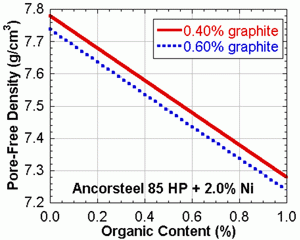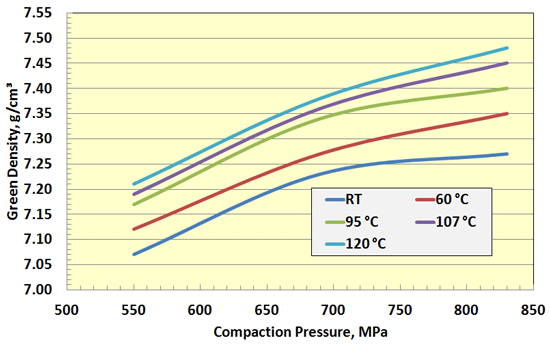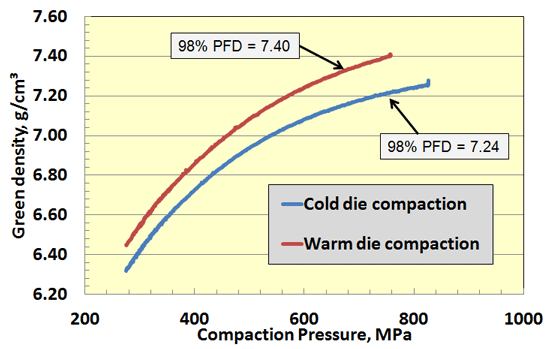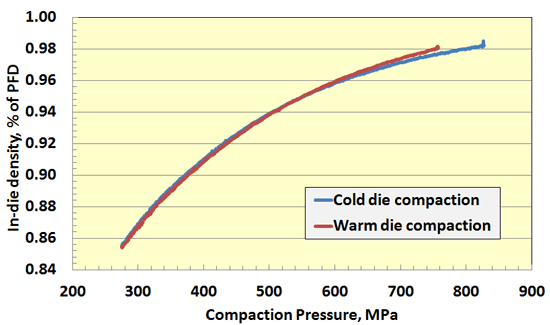Binder/lubricant developments enhance Powder Metallurgy part quality and strength
Dr. David Whittaker reviews this presentation exclusively for ipmd.net
Traditionally, the PM structural parts industry has had a love-hate relationship with pressing lubricants. They are vital in terms of protecting components and tooling during the forming and ejection processes, but can cause a range of process problems during sintering.
PM’s initial approach to pre-mixing, the simple mixing of elemental ingredients, was simple and cost effective but gave potential problems with segregation in mixes. Next, diffusion alloying appeared as an effective means of preventing segregation of the metallic alloying elements and improving control over dimensions and strength. However, this approach could do nothing about segregation and dusting problems associated with graphite and lubricant additions. Hence, binder treatments were developed as a means of tackling these issues.
Initially, oils were investigated as a means of controlling dusting. This was a simple approach but carried a number of disadvantages; mixes were not totally dry, flow rate and apparent density tended to change with time and also, generally, apparent density was reduced.
These issues stimulated interest in the use of polymer bonding (in Hoeganaes Corporation’s case, ANCORBOND® processing). The first generation of such developments produced the targeted benefits of improved flow rates, reduced dusting and higher apparent densities, but, because the binders were in addition to the normal pressing lubricants, the higher total organic content in mixes restricted pore-free density and therefore achievable green density levels.
The second generation of developments therefore concentrated on finding polymer additions that can deliver both bonding and lubrication.

Fig. 1 The effects of graphite and organic contents
on Pore-Free Density (As presented at PowderMet
2012, 10-13 June 2012, Nashville, USA. Courtesy
Hoeganaes)
In early lubrication trials, it soon became apparent that maximum achievable green density was dependent on a parameter, referred to as Pore Free Density (PFD) and defined as the density of a green compact if all of the porosity could be removed.
The low density additions of graphite and lubricant/binder have particularly negative effects on PFD (Fig. 1). It was also observed that the practical limit of green density is around 98% of PFD (beyond this limit, formation of micro-laminations is likely) and, hence, the main potential route to higher green densities lay in raising PFD. Potential means of achieving this aim include:
- Working with lower lubricant/binder levels
- Raising compaction die temperature
The development of further generations of binder/lubricants, often tailored for use in Warm Die Compaction, have contributed to and continue to contribute to furthering the above objectives.

Fig. 2 Comparison of ejection characteristics of various lubrication systems (all compaction at 830 MPa) – Material FN-0205 (As presented at PowderMet 2012, 10-13 June 2012, Nashville, USA. Courtesy Hoeganaes)
The proprietary binder/lubricant, AncorMax 200, specifically developed for Warm Die Compaction at a tooling temperature of around 93°C, is generally used at a 0.4 wt% addition level whereas a “new lube system” was revealed by the author, which is designed to be used at a level of only 0.25 wt%. and for use at a tooling temperature of around 107°C.
Fig. 2 demonstrates that these binder/lubricants, used at these addition levels and tooling temperatures, provide superior ejection properties to 0.75 wt% EBS in room temperature compaction and 0.4 wt% EBS in compaction at room temperature or at 97°C.

Fig. 3 Effect of temperature on green density. Material FLN2-4400 (As presented at PowderMet 2012, 10-13 June 2012, Nashville, USA. Courtesy Hoeganaes)
Work reported by several major powder suppliers has shown that the “real” green density increases as compaction temperature increases and this is amply demonstrated by the Hoeganaes Corporation data in Fig. 3.

Fig. 4 In-die density vs. compaction pressure. Material FLN2-4405 (As presented at PowderMet 2012, 10-13 June 2012, Nashville, USA. Courtesy Hoeganaes)
It has often been postulated that this effect is related to a reduction of flow stress of the ferrous powder grade over this temperature range. However, it is clear that the use of a binder/lubricant, specifically designed to operate effectively at the increased temperature levels and used at lower addition levels, must also be playing a significant role, as evidenced by the comparison between Figs. 4 and 5.
In these figures, the powder mix used in cold compaction contained 0.75 wt% Acrawax, whereas that used in Warm Die Compaction contained only 0.4 wt% of a proprietary binder/lubricant. The two compressibility curves appear very different, when plotted in terms of green density in Fig. 4, but virtually coincide when plotted in terms of PFD in Fig. 5.

Fig. 5 In-die PFD vs compaction pressure. Material FLN2-4405 (As presented at PowderMet 2012, 10-13 June 2012, Nashville, USA. Courtesy Hoeganaes)
The “new lubricant system” under development is particularly interesting in that it offers the potential, for the first time, to lower the premix organic content to only 0.25 wt%. This allows PFD to be increased by 0.07 to 0.10 wt%. By employing a part ejection temperature of 107°C (225°F), it has been proved feasible, in laboratory pressing trials, to achieve green densities of up to around 7.47 g/cm3 and limited prototype production has shown similar results. As demonstrated in Fig. 2, this is accompanied by a reduction in ejection forces.
Limited work with a Double Press-Double Sinter process at a high compaction pressure of 830 MPa has also shown that the generation of sintered densities over 7.6 g/cm3 is feasible with this system.
News | Articles | Market reviews | Search directory | Subscribe to e-newsletter





